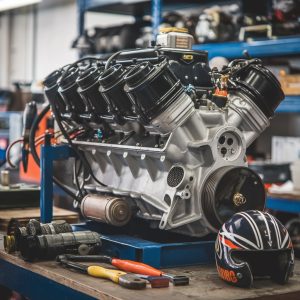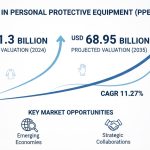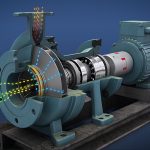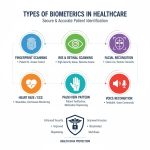The Evolution and Future of High-Speed Engines: Powering Global Industries
The Global High Speed Engine Market stands as a cornerstone of modern industrial infrastructure, with its valuation reaching USD 20.92 billion in 2022. Industry projections indicate substantial growth, with the market expected to expand to USD 29.97 billion by 2030, representing a steady compound annual growth rate (CAGR) of 4.60%. This growth trajectory underscores the critical role these engines play across diverse sectors including power generation, marine applications, and heavy machinery operations. High-speed engines, typically operating above 1000 RPM, have become indispensable in scenarios requiring rapid power delivery and operational efficiency. The market’s expansion reflects increasing global energy demands, particularly in developing economies where industrialization continues at an accelerated pace. These engines have evolved significantly over recent decades, with manufacturers focusing on enhancing fuel efficiency, reducing emissions, and improving overall performance metrics to meet increasingly stringent regulatory standards worldwide.
Market segmentation reveals distinct categories based on power output, with engines ranging from 0.5-1 MW, 1-2 MW, 2-4 MW, and above 4 MW, each serving specific industrial applications. The 1-2 MW segment currently dominates market share due to its versatility across multiple applications including emergency power generation and marine propulsion systems. Further segmentation by fuel type shows diesel engines maintaining market leadership, though natural gas variants are gaining significant traction due to their lower environmental impact. End-user segmentation demonstrates power generation as the primary application, followed closely by marine and railway transportation sectors. This diverse application base provides market stability even during economic fluctuations, as demand shifts between sectors rather than disappearing entirely. The market also exhibits cyclical patterns influenced by global infrastructure development projects, shipping industry health, and regional electrification initiatives. Recent technological innovations have focused on digitalization, with smart monitoring systems and predictive maintenance capabilities becoming standard features in premium engine offerings, allowing operators to optimize performance and extend operational lifespans while minimizing downtime.
The competitive landscape remains dynamic, with established manufacturers facing challenges from emerging market players offering cost-effective alternatives. This competition has accelerated innovation cycles, benefiting end-users through improved product offerings and more competitive pricing structures. Market analysts note that customization capabilities have become a key differentiator, with successful manufacturers developing modular designs that can be rapidly adapted to specific customer requirements. The aftermarket service segment has also emerged as a significant revenue stream, with maintenance contracts and parts supply chains representing approximately 30% of total market value. Regional market penetration varies significantly, with developed economies focusing on replacement and efficiency upgrades while developing regions drive new installation growth. The technological gap between premium and economy segments continues to narrow as innovations trickle down through the market, creating more accessible entry points for new customers while challenging manufacturers to continuously advance their flagship offerings to maintain price premiums. Despite global economic uncertainties, the essential nature of high-speed engines in critical infrastructure ensures consistent baseline demand, with growth fluctuations primarily affecting discretionary applications rather than core market segments.

Key Takeaways
- The global high-speed engine market is projected to grow from 20.92 billion in 2022 to 29.97 billion by 2030, with a CAGR of 4.60%.
- Backup power solutions, maritime applications, and industrial development are primary growth drivers across diverse sectors.
- Asia Pacific dominates with 40% market share, while North America shows rapid growth in grid resilience applications.
- Major players include Caterpillar, Cummins, Rolls-Royce Power Systems, Wärtsilä, and MAN Energy Solutions, with emerging competition from Asian manufacturers.
- Stringent environmental regulations present challenges but also drive innovation in emissions reduction technologies.
- High operational costs and maintenance requirements remain significant market constraints.
- Future growth opportunities include hybrid power systems, alternative fuels (including hydrogen), and rural electrification projects.
- Digitalization trends are transforming the industry with predictive maintenance and remote monitoring capabilities.
- Supply chain vulnerabilities exposed by COVID-19 have prompted strategic reconsiderations across the industry.
- Market segmentation by power output shows the 1-2 MW segment currently dominating due to its versatility across applications.
Key Growth Factors Driving Market Expansion
The expansion of the high-speed engine market is propelled by several interconnected factors, with the rising demand for reliable backup power solutions standing as perhaps the most significant driver. As digital infrastructure becomes increasingly critical to business operations and daily life, the cost of power interruptions has escalated dramatically, making investment in dependable backup generation systems an operational necessity rather than a contingency luxury. This trend spans across sectors from data centers and telecommunications to healthcare facilities and financial institutions, where even momentary power disruptions can result in substantial financial losses or life-threatening situations. The growing frequency of extreme weather events and aging power infrastructure in many regions has further accelerated this demand, with organizations increasingly implementing comprehensive power resilience strategies that frequently incorporate high-speed engines as primary or secondary backup systems. This application segment has seen particular growth in regions with unreliable grid infrastructure, where businesses must ensure operational continuity despite frequent outages.
The maritime sector represents another substantial growth vector, with high-speed engines playing a crucial role in both commercial shipping and the expanding leisure marine market. The global cruise industry, despite temporary setbacks during the pandemic, has resumed its long-term growth trajectory, with new vessel commissions requiring advanced propulsion systems that balance power delivery with fuel efficiency and emissions compliance. Similarly, the commercial shipping industry continues to expand in response to growing global trade volumes, with high-speed engines finding applications in medium-sized vessels and auxiliary power systems on larger ships. The fishing industry, particularly in developing economies, has also embraced high-speed engines as fleets modernize to improve operational range and efficiency. Maritime regulations regarding emissions in coastal waters and ports have stimulated demand for newer, cleaner engine technologies, creating replacement cycles even in otherwise mature markets. The offshore energy sector, including both traditional oil and gas operations and emerging offshore wind installation and maintenance activities, represents another maritime application driving specialized high-speed engine demand.
Urbanization and industrialization trends, particularly in Asia Pacific and African regions, continue to create substantial market opportunities as new manufacturing facilities, commercial developments, and infrastructure projects require reliable power solutions. The expansion of manufacturing capabilities in previously rural areas often outpaces grid infrastructure development, necessitating localized power generation solutions where high-speed engines offer ideal characteristics including rapid deployment, scalability, and operational flexibility. Mining operations in remote locations similarly rely on these engines for both primary and backup power generation. The development of special economic zones and industrial parks across emerging economies has created concentrated demand centers for high-performance power generation equipment. Additionally, the global push toward distributed energy systems rather than centralized generation models has created new application scenarios for medium-sized high-speed engines that can be deployed in community-scale power networks. The telecommunications expansion into previously underserved regions requires reliable power solutions for remote tower installations, creating another consistent demand segment. Construction industry growth, particularly in rapidly developing urban centers, drives demand for both temporary power solutions during project execution and permanent installations in completed facilities. These diverse growth factors collectively ensure that high-speed engines remain essential components across multiple industries, with technological advancements continuously expanding their application potential.
Regional Analysis of Market Dynamics
The Asia Pacific region maintains undisputed dominance in the high-speed engine market, accounting for approximately 40% of global market share. This leadership position stems from several regional factors, including China and India’s accelerated industrialization trajectories, extensive maritime activities across Southeast Asian nations, and substantial investments in backup power infrastructure to support manufacturing and technology sectors. China’s Belt and Road Initiative continues to drive significant infrastructure development across the region, creating consistent demand for power generation equipment including high-speed engines. The region’s shipbuilding industry, concentrated in South Korea, China, and Japan, represents another major consumption center for marine-grade high-speed engines. Domestic manufacturing capabilities for these engines have expanded substantially across the region, with several Asian manufacturers now competing effectively in global markets through competitive pricing and increasingly sophisticated technological offerings. The region’s vulnerability to natural disasters, particularly in island nations and coastal areas, has stimulated investment in resilient power systems, further driving market growth. Regulatory frameworks regarding emissions and efficiency standards vary significantly across the region, creating complex market dynamics where manufacturers must offer diverse product portfolios to address different national requirements.
North America presents a distinct market profile characterized by mature infrastructure but rapid growth in specific segments, particularly those related to grid resilience and emergency preparedness. The region’s aging electrical infrastructure has created substantial demand for backup power solutions across commercial, healthcare, and data center applications. The United States military remains a significant consumer of specialized high-speed engines for both mobile and stationary applications. The region’s oil and gas industry, despite fluctuations in activity levels, continues to require high-performance engines for various extraction, processing, and transportation operations. The North American market places particular emphasis on emissions compliance and fuel flexibility, with natural gas variants gaining substantial market share due to the region’s abundant natural gas resources and well-developed distribution infrastructure. The region’s focus on technological innovation has made it a testing ground for advanced engine management systems and alternative fuel adaptations. Canada’s remote northern communities represent a specialized market segment requiring extremely reliable cold-weather performance from power generation equipment. The region’s substantial agricultural sector also drives demand for irrigation pumping applications in water-stressed areas.
European market dynamics reflect the region’s stringent environmental regulations and focus on sustainability, with manufacturers prioritizing emissions reduction technologies and fuel efficiency improvements. The region leads in the adoption of natural gas and dual-fuel high-speed engine variants. Europe’s extensive inland waterway transportation network creates specialized demand for marine engines meeting the region’s strict emissions standards for operation in populated areas. The region’s emphasis on combined heat and power (CHP) applications has created a distinct market segment where high-speed engines are valued for their thermal efficiency characteristics in addition to electrical generation capabilities. The Middle East and Africa region presents contrasting market conditions, with oil-producing nations focusing on high-performance applications while developing economies prioritize cost-effectiveness and operational simplicity. The region’s extreme climate conditions create specialized requirements for cooling systems and dust protection features. Latin America’s market growth correlates strongly with infrastructure development initiatives and mining sector activities, with Brazil and Mexico representing the largest regional markets. These diverse regional dynamics necessitate localized market approaches from global manufacturers, with product offerings and service networks tailored to specific regional requirements and operational conditions.
Major Players and Competitive Landscape
The high-speed engine market features a blend of established industrial powerhouses and specialized manufacturers, with companies like Caterpillar, Cummins, Rolls-Royce Power Systems, Wärtsilä, and MAN Energy Solutions maintaining significant market positions through extensive product portfolios and global service networks. These industry leaders have secured their positions through decades of technological development, brand reputation, and comprehensive aftermarket support capabilities that provide customers with lifetime value propositions extending far beyond initial equipment purchase. Caterpillar’s integration of advanced digital technologies into its engine management systems exemplifies how established players leverage their research capabilities to maintain competitive advantages. Cummins has distinguished itself through fuel system innovations that enhance efficiency across diverse operating conditions. Rolls-Royce Power Systems (including its MTU brand) maintains leadership in premium marine applications where performance parameters are particularly demanding. The competitive landscape has evolved significantly in recent years with the emergence of strong regional manufacturers, particularly from China and India, who have rapidly advanced their technological capabilities while maintaining cost advantages through localized production and supply chains.
Recent technological advancements have centered around emissions reduction, fuel flexibility, and digitalization. Selective catalytic reduction (SCR) systems have become standard in many markets to meet NOx emissions requirements, while particulate filter technologies continue to evolve for applications where ultra-low emissions are required. The integration of hydrogen blending capabilities represents an emerging frontier, with several manufacturers demonstrating engines capable of operating with hydrogen percentages between 10-30% mixed with traditional fuels. Digital twins and advanced simulation capabilities have accelerated development cycles while reducing physical testing requirements. Remote monitoring systems now provide real-time performance data and predictive maintenance alerts, fundamentally changing service models from reactive to proactive approaches. Acquisitions and strategic partnerships have reshaped the competitive landscape, with traditional engine manufacturers acquiring or partnering with technology companies to accelerate digital capabilities development. Vertical integration strategies have become increasingly common, with manufacturers expanding into component production to secure supply chains and protect proprietary technologies. Joint ventures between established Western manufacturers and emerging market companies have created new competitive entities combining technological sophistication with cost-effective production capabilities.
Market leaders employ diverse strategies to maintain their positions, with differentiation approaches varying significantly between premium and value-oriented manufacturers. Premium segment players emphasize total lifecycle cost advantages through fuel efficiency, reliability, and reduced maintenance requirements, effectively countering higher initial purchase prices with operational savings. Value-oriented manufacturers focus on initial cost competitiveness while gradually enhancing performance specifications to narrow the capability gap with premium offerings. Service network development represents a critical competitive factor, with successful manufacturers establishing comprehensive global support capabilities through both direct presence and authorized service partner networks. Financing solutions have emerged as significant competitive tools, particularly for large-scale projects where capital constraints might otherwise limit customer options. Customization capabilities represent another differentiation vector, with manufacturers developing modular design approaches that enable rapid adaptation to specific application requirements without sacrificing economies of scale in core component production. Research and development investments remain substantial across leading companies, with emissions compliance, fuel efficiency, and digitalization representing primary focus areas. The industry’s competitive dynamics continue to evolve as environmental regulations tighten globally, creating both challenges and opportunities for manufacturers capable of delivering compliant solutions without compromising performance or significantly increasing costs.
Challenges Limiting Market Potential
Despite robust growth projections, the high-speed engine market faces substantial challenges that constrain its expansion potential. Chief among these limitations are the considerable operational and maintenance costs associated with these sophisticated power systems. Initial acquisition expenses represent only a fraction of lifetime ownership costs, with fuel consumption typically accounting for 60-80% of total operational expenses depending on application and duty cycle. Maintenance requirements remain intensive despite technological advancements, with specialized technical expertise necessary for optimal performance management and troubleshooting. This expertise gap presents particular challenges in developing regions where qualified technician availability remains limited, often necessitating expensive service contracts with original equipment manufacturers or authorized representatives. Parts availability and supply chain logistics create additional complexity, especially for installations in remote locations where inventory management becomes critical to avoid extended downtime during maintenance events. The substantial weight and space requirements of high-speed engines and their associated systems (cooling, exhaust treatment, fuel storage) limit their application in space-constrained environments, creating opportunities for alternative technologies in certain market segments. The significant upfront capital investment required for high-speed engine installations creates market entry barriers, particularly for smaller organizations and projects with limited financing options.
Environmental regulations represent another significant constraint, with increasingly stringent emissions standards requiring sophisticated aftertreatment systems that add cost, complexity, and maintenance requirements. The regulatory landscape varies substantially between regions, creating compliance challenges for global manufacturers and operators of international fleets. European Stage V emissions standards and the International Maritime Organization’s regulations have established particularly demanding requirements that necessitate substantial engineering investments. The carbon reduction commitments adopted by many nations and corporations create additional pressure on internal combustion technologies, with some market segments increasingly exploring alternative power solutions despite their current limitations. Noise regulations in urban environments further complicate installations, requiring substantial sound attenuation measures that increase system footprint and cost. The regulatory uncertainty regarding future emissions standards creates planning challenges for both manufacturers and end-users, potentially delaying investment decisions as organizations await regulatory clarity. The growing social pressure regarding environmental impact extends beyond formal regulations, with some organizations avoiding fossil fuel technologies regardless of their compliance with current standards, particularly in consumer-facing applications where public perception influences decision-making.
The COVID-19 pandemic exposed and exacerbated supply chain vulnerabilities across the manufacturing sector, with high-speed engine production particularly affected due to its reliance on globally distributed component suppliers and specialized materials. While immediate disruptions have largely resolved, the experience has prompted fundamental reconsiderations of supply chain strategies, with increased emphasis on resilience potentially at the expense of maximum efficiency. Component shortages, particularly for electronic control systems and specialized alloys, continue to create production constraints and extended lead times in certain product categories. Labor shortages in manufacturing and service sectors further complicate both production and maintenance operations. The pandemic’s economic impact has delayed capital investment across multiple sectors, creating pent-up demand but also providing opportunities for alternative technologies to gain market share during the transition period. These challenges collectively moderate growth projections and create strategic imperatives for industry participants to develop more resilient business models capable of navigating an increasingly complex operational environment while maintaining competitive cost structures and technological advancement trajectories.
Future Opportunities and Trends
The future of the high-speed engine market will be significantly shaped by innovations in hybrid power generation systems that combine traditional engine technology with battery storage, renewable energy inputs, and sophisticated control systems. These hybrid configurations address several current limitations by optimizing engine operation for maximum efficiency, reducing maintenance requirements through decreased running hours, and improving overall system reliability through redundancy. The integration of battery storage enables peak shaving capabilities that allow engines to operate at optimal loads rather than following demand fluctuations, substantially improving fuel efficiency and reducing emissions. Smart control systems that predictively manage power flows between different generation sources and storage components represent a major value-added opportunity for manufacturers capable of delivering integrated solutions rather than standalone equipment. Microgrid applications combining high-speed engines with solar, wind, and storage technologies are gaining traction in both remote locations and grid-connected installations seeking enhanced resilience. The hybridization trend extends to marine applications, where battery-engine combinations enable zero-emission operation in environmentally sensitive areas while maintaining conventional propulsion capabilities for longer voyages. This technological convergence creates both opportunities and challenges for traditional engine manufacturers, requiring expanded expertise beyond mechanical systems into electrical engineering and software development domains.
Emerging transportation sector technologies present additional growth vectors, particularly in specialized applications where battery-electric solutions face limitations. The heavy-duty long-haul transportation segment continues to evaluate high-efficiency internal combustion engines as bridge technologies during the transition toward zero-emission alternatives. The aviation industry’s exploration of sustainable aviation fuels creates potential applications for adapted high-speed engines in ground support equipment and smaller aircraft categories. The rail sector’s ongoing modernization in many regions includes replacement of older locomotive power plants with more efficient high-speed engine alternatives, particularly in regions where full electrification remains economically challenging. Specialized off-highway applications in agriculture, construction, and mining continue to rely on high-performance engines where power density, durability, and operational flexibility remain prioritized over other considerations. The development of synthetic and biofuels compatible with existing engine architectures represents another significant opportunity, potentially extending the viable lifecycle of internal combustion technologies while reducing their environmental impact. Hydrogen and hydrogen-derivative fuels represent particularly promising avenues, with several manufacturers demonstrating engines capable of operating on pure hydrogen or hydrogen-natural gas blends with minimal modifications to existing architectures.
Rural electrification initiatives across developing regions present substantial opportunities for distributed generation solutions incorporating high-speed engines, particularly in areas where grid extension remains economically challenging or technically difficult. These applications typically prioritize reliability, simplicity of maintenance, and fuel flexibility over maximum efficiency, creating distinct market requirements from those in more developed regions. Community-scale power systems serving village clusters represent a particularly promising application, with engine-based generation providing reliable baseline power that can be supplemented by renewable sources as infrastructure develops. Agricultural processing applications in rural areas create additional demand for reliable power generation to support value-added activities that improve economic outcomes for farming communities. The telecommunications expansion into previously underserved regions similarly requires dependable power solutions for remote installations. These rural applications often serve as entry points for manufacturers into developing markets, establishing brand presence and service networks that can later support expansion into more sophisticated applications as regional economies develop. The future high-speed engine market will likely feature increasing technological divergence between premium applications emphasizing maximum performance and efficiency versus value-oriented solutions prioritizing simplicity, durability, and cost-effectiveness across diverse operating environments, creating distinct market segments with different growth trajectories and competitive dynamics.
FAQs
- What factors are driving the growth of the Global High Speed Engine Market?
- How is the market projected to change from 2022 to 2030?
- What is the expected CAGR for the Global High Speed Engine Market during the forecast period?
- What was the market value of the Global High Speed Engine Market in 2022?
☎ Contact Us:
224 W 35th St Ste 500 New York,
USA/Canada Toll Free +1(877) 462-2282
+1(212) 951-1369
✉ Email: [email protected]
🌐 Website: https://www.vantagemarketresearch.com
![[Market Research Reports] – Research Google News Blog | VMR.Biz](https://www.vmr.biz/wp-content/uploads/2022/12/logo-removebg-preview.png)











